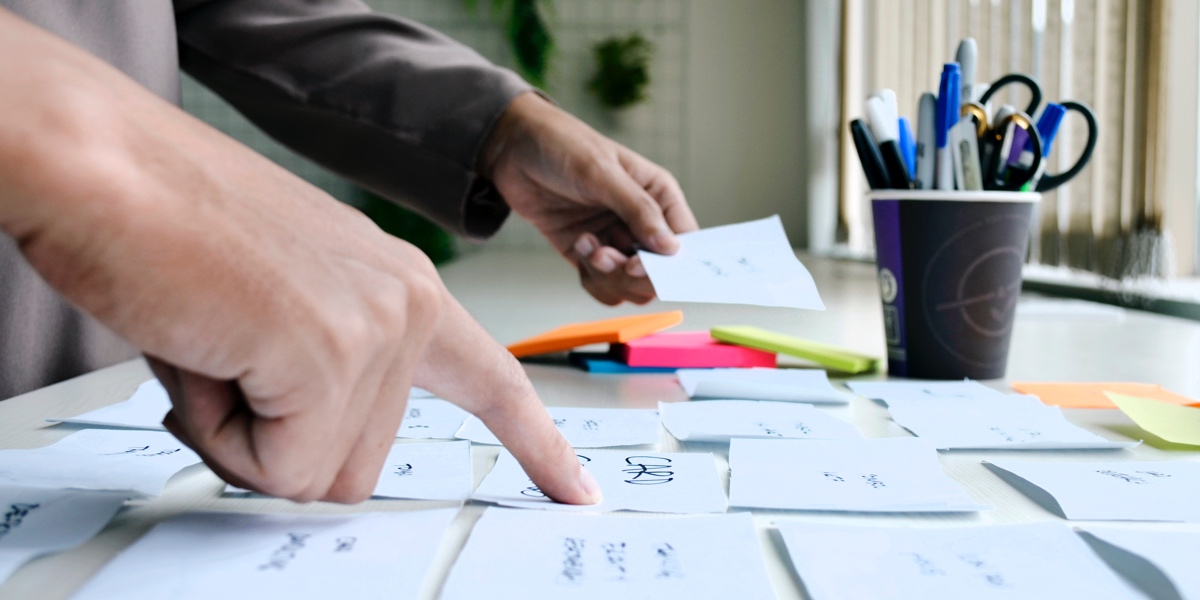User-centered design (UCD) is an approach to design that puts users’ needs front and center and follows an iterative design process that focuses on the user’s needs every step of the way. UCD is used frequently in the product design world as both designers and business executives are reaping the benefits of incorporating their users’ needs into design decisions from the very first ideations to the final delivery.
The goal of user-centered design is to learn about the user and let their needs, values, and expectations guide the design process from start to finish. How do designers achieve this goal? Well, there are a few key steps and guidelines to follow when conducting quality user-centered design. This article explains what those steps are, how to execute them, tools you may need, and important factors to consider throughout the process.
Here’s what we’ll cover:
- Why embrace user-centered design?
- The user-centered design process
- Tools and resources for user-centered design
- Key takeaways
Ready to learn about conducting user-centered design? Let’s get into it!

Photo by UX Indonesia on Unsplash
1. Why embrace user-centered design?
Before we get into how to conduct user-centered design, it’s important to understand why you should conduct it in the first place.
Here’s are a few of the advantages of user-centered design:
- Higher customer satisfaction and engagement
- Provides cost and risk reduction as there is less chance of creating unsatisfactory products
- Increases designer productivity and lessens the need for excessive re-designs
- Keeps all team members focused on both the user and overall company goals
- Creates a deeper sense of empathy
This is just a quick list of perks the user-centered design process can offer. Recognizing the value UCD brings to product creation and how it can benefit your company can help focus your design team and keep stakeholders or other team members invested and on the same page.
It’s also important to understand that user-centered design and design thinking are not synonymous! Learn the differences here: User-Centered Design vs. Design Thinking.
2. The user-centered design process
User-centered design is usually expressed as a four-step process:
- Understand the user and context of use
- Specify user and business requirements
- Create design solutions
- Evaluate effectiveness
For each step, we’ll break down what happens, why, and techniques to get the most out of your work. Let’s get to it!
Step 1: Understand the user and context of use
The first step in the UCD process is to research your user and how they will use your product. A great deal of UX research is being conducted at this phase to find out what types of people will be using the product, what their goals and motivations are, the problems they face, and their general needs and behaviors.
This is probably the most important step of the UCD process. If you don’t know who your users are and the context in which they’ll be interacting with your product, it will be very difficult to design something tailored to their needs and personalities. Typically, information about the user is gathered using qualitative UX research—which uses surveys and interviews, focus groups, questionnaires, and more.
To learn more about UX research (and how to do it inclusively), check out this video:
User personas and user journey maps are also important during this phase. Personas give the design team a generalized representation of your users so they can have a clear picture of the people they are designing for, their goals, skills, attitudes, problems, lifestyle etc. We’ll talk about some easy ways to create user personas later on. Journey maps give you an idea of how users move through the user experience (in common use cases).
When you’re trying to determine how users will interact with your product you’ll want to find out three things:
- The medium they will be using (ie. desktop vs. smartphone)
- The environment in which the interaction will take place
- Their emotional state at each phase in the user journey.
Step 2: Specify user and business requirements
With a solid understanding of who will be using your product and how, you can start to define company goals and the metrics you’ll use to measure your progress. Without this step, it will be hard to assess why the design is beneficial to both the user and your company or when you’ve reached a successful final product.
You’ll want to have a good understanding of both the user’s expectations and your company requirements. Here are some questions to ask yourself when defining each:
Business requirements
- What is your expected revenue?
- How much time and resources do you have to invest?
- What is the scope of the design? (ie. major deliverables, milestones, deadlines, boundaries)
- Who are your key stakeholders?
User requirements
- What problems is the design solving?
- What does a successful solution look like?
- What has the user gained from using this product?
Using a UX strategy and defining the project scope can be particularly useful for this phase. We’ll link some helpful resources for those tasks in section three. Let’s move on to the next step.

Step 3: Create design solutions
Now that you have a clear idea of your users needs and company goals, it’s time to start designing solutions. This phase is what most designers are familiar with and consists of deciding on and building various product features and assets.
Keeping the information you’ve gathered about your users in mind, this is where you’ll start on completing tasks like:
- User flows
- Information architecture and site maps
- Deciding on colors, icons, images, language and tone
- Wireframing and prototyping
- Designing user onboarding
- UX copywriting
- Accessibility features
It’s crucial to ensure that the design decisions you are making are being guided and informed by what you know about your users and the problem at hand. Similarly, you’ll want to keep business requirements in mind to be sure you are staying within company budget and guidelines.
Step 4: Evaluate effectiveness
Once you’ve come up with some preliminary solutions, it’s time to analyze and evaluate your designs and see if they have met the goals you set in step two. Here is where you’ll take an overall look at the product and compare it against the user and business requirements. The best way to do this is via usability testing with actual users.
During your tests you’ll want to pay close attention to your users ask yourself questions like:
- How are our users responding to the product?
- What is going well? What isn’t working?
- Did the product solve the users problem?
- What can be improved and how?
- Are company goals met? Why or why not?
There are many ways to conduct usability testing and we’ll share some valuable resources further on. But the most important things to remember are to step back and listen to the users feedback. Observe both their verbal and non-verbal reactions and document their responses well.
You may not have a successful product on the first go-around and that is completely normal! The UCD process is iterative and may take a few rounds to get it right. Which brings us to our bonus and final step…
(Bonus) Step 5: Iterate
While this isn’t necessarily a “step” in the process, it is a vital part of the UCD process to discuss. Once you’ve tested your designs and obtained user feedback, it’s time to begin the process again, this time taking all the invaluable information you’ve gathered from the first design cycle with you and having it inform your future design choices.
In subsequent rounds of design, you’ll be able to tweak and fix aspects of your product that didn’t work so well and make impactful changes to better serve your users. It may take a few cycles of the UCD process to get your product right, but that is to be expected. Even after your final product is developed and released, further evaluation and iteration may be necessary.

3. Tools and resources for user-centered design
User-centered design can be an intricate process, but there are lots of great resources to help your UCD experience go smoothly. Here are a few resources to some of the concepts and tools we discussed above.
User personas
- 5 Steps to Create Your User Persona (with downloadable template)
- How to define a user persona
- What is a user persona spectrum?
- User personas vs. job-to-be-done
User journey maps
- What are customer journey maps and why do they matter
- How to make a customer journey map in 7 simple steps
- Customer journey map template
UX strategy
Defining project scope
- What is a project scope?
- What is a project scope? Defining and outlining project success
- 6 Steps to define the scope of a project
Usability testing
- What is usability?
- 11 Usability heuristics every designer should know
- How to write effective usability testing questions
- A guide to usability testing—tools, methods, and examples
4. Key takeaways
The UCD process continues to help businesses turn out engaging products with high customer satisfaction. Knowing how to conduct quality user-centered design can help you make your users happy and achieve your company goals.
The most important things to keep in mind when using UCD is to involve the users early and at every subsequent step and iteration. Empathizing with the users’ needs as well as incorporating their feedback into your design and development process can help you create impactful products that fulfill both company and user goals.
